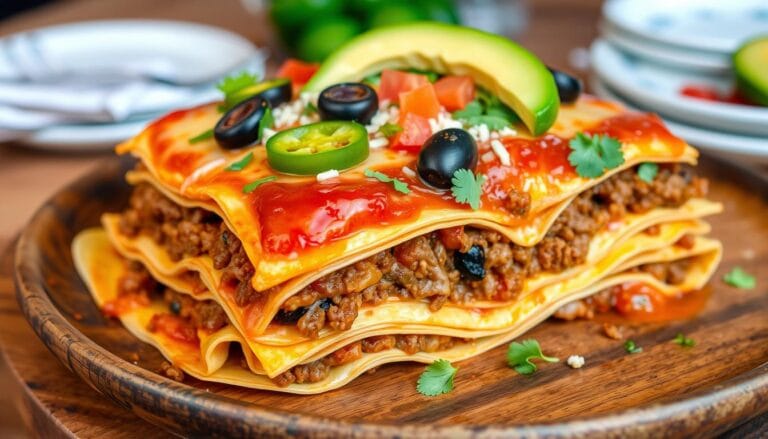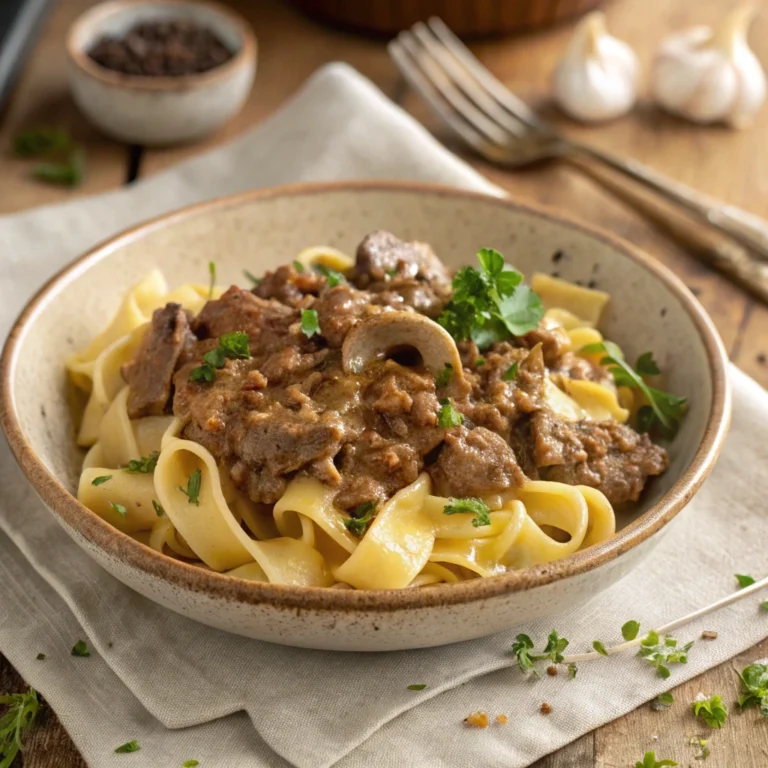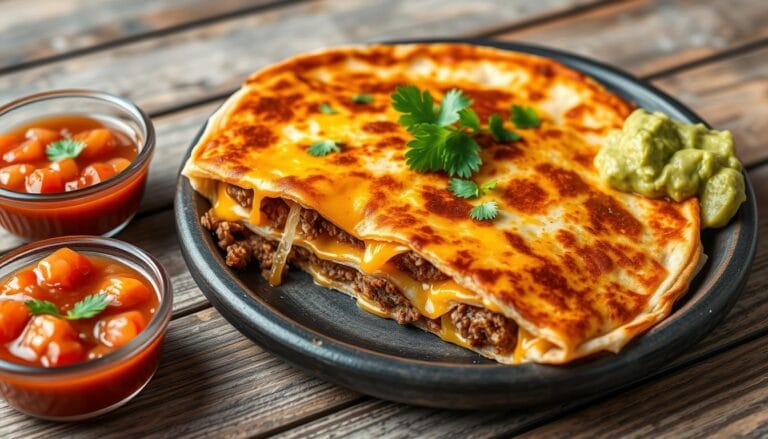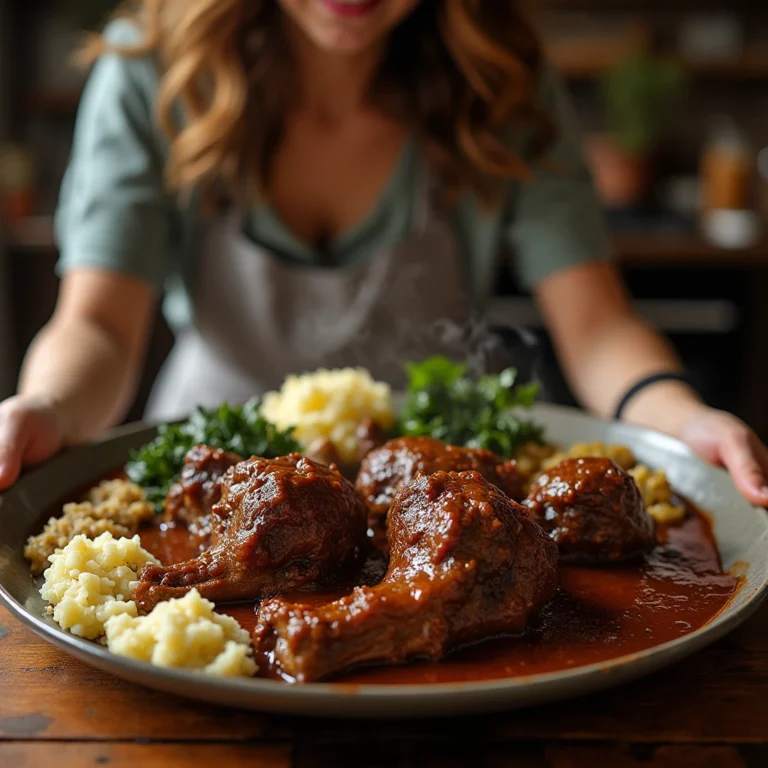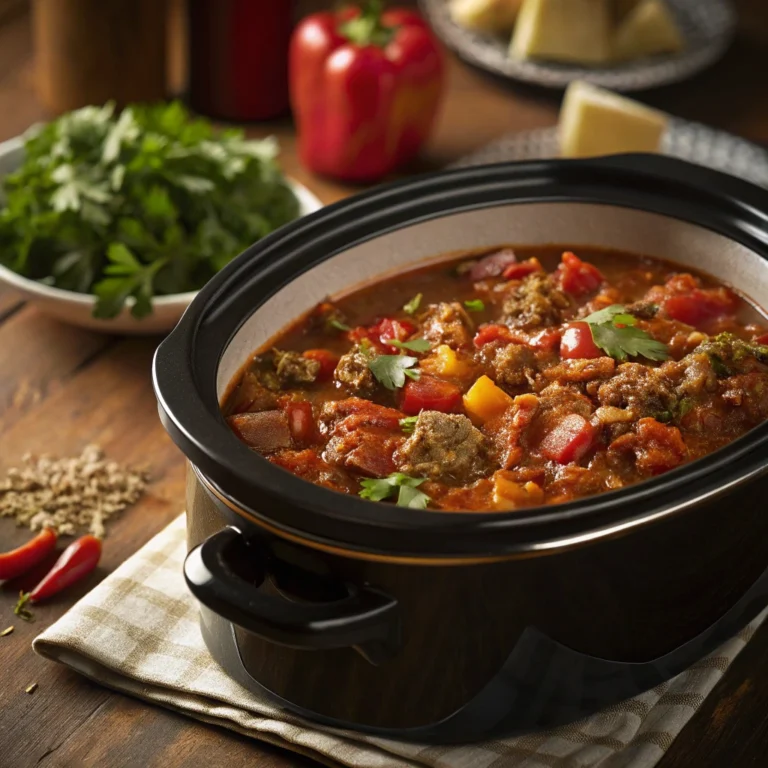Pares Recipe: A Guide to the Famous Filipino Beef Dish”
As you walk through Manila’s busy streets, you’ll catch the scent of garlic and beef. It’s a call to try pares recipe, a favorite comfort food in the Philippines. This dish combines savory beef, fragrant rice, and a light broth, loved by many.
The word “pares” means “pairs” in Filipino. It’s a perfect name for this dish, where beef, rice, and broth come together beautifully. From its start as a street food in Quezon City to now, pares recipe has grown. Yet, it still holds the charm that makes it a favorite in Filipino cuisine.
The Origins and History of Beef Pares in Filipino Cuisine
Pares, a beloved Filipino beef dish, has a fascinating history. It traces its roots to the vibrant streets of Quezon City. The story begins with Lolita Tiu, the visionary behind its inception.
The Birth of Pares in Quezon City
In 1979, Lolita Tiu opened a modest carinderia, or small eatery, called Jonas near Calle Retiro (now N.S. Amoranto Sr. Street) in Quezon City. It was here that she introduced the now-iconic pares dish. This dish is a fusion of tender beef, savory broth, and aromatic garlic rice.
At first, pares was a popular street food. It captured the hearts and palates of the local community. Its rich, comforting flavors and affordability made it a favorite among workers, students, and passersby.
Evolution from Street Food to Restaurant Staple
As pares’ popularity grew, it moved beyond its humble street food origins. Small eateries and specialized roadside diners called paresan started to feature pares on their menus. This introduced the dish to a wider audience.
The widespread appeal of pares led to its inclusion in restaurant menus across the Philippines. Today, pares is a beloved comfort food. It’s treasured for its ability to evoke nostalgic memories and bring people together around the table.
“Pares is more than just a dish; it’s a culinary legacy that has become ingrained in the fabric of Filipino culture.”
Understanding the Components of Traditional Pares
Pares is a beloved Filipino beef dish. It combines beef asado, garlic fried rice, and beef broth soup. This mix is a staple in Filipino cuisine, offering a satisfying and flavorful meal.
The heart of pares is the beef asado. It’s a tender beef stew in a sweet-savory soy sauce. This slow-cooked beef showcases the rich Filipino flavors passed down through generations.
The garlic fried rice, or sinangag, adds a delightful crunch. It’s infused with the aroma of crispy, golden-brown garlic. This creates a perfect balance with the savory beef.
The beef broth soup rounds out the dish. It can be made from the beef asado’s cooking liquid or with beef bouillon cubes. This light soup cleanses the palate and complements the dish’s richness.
Together, the beef asado, garlic fried rice, and beef broth form the quintessential pares dish. It’s a beloved and iconic representation of Filipino flavors that has won many hearts and taste buds.
| Component | Description |
|---|---|
| Beef Asado | Tender, slow-cooked beef stew in a sweet-savory soy-based sauce |
| Garlic Fried Rice | Fragrant, crispy-edged rice infused with the aroma of browned garlic |
| Beef Broth Soup | Clear, nourishing soup made from the beef cooking liquid or beef bouillon |
“Pares is a harmonious blend of tender beef, fragrant rice, and comforting broth – a true delight for the senses and a cherished part of Filipino culinary heritage.”
Essential Ingredients for Authentic Beef Pares
Making the perfect beef pares is all about the right mix of ingredients. At its core, the dish features tender beef brisket or other cuts. Soy sauce, brown sugar, and star anise give it a unique flavor. Onions, garlic, and ginger add a fragrant touch.
Key Aromatics and Spices
The base of beef pares is built on three key ingredients:
- Onions: Diced or sliced, onions add depth and sweetness.
- Garlic: Minced or crushed, garlic boosts the savory taste.
- Ginger: Fresh ginger, whether julienned or grated, adds warmth and earthiness.
Star anise, a key spice in Filipino cooking, gives the dish a subtle licorice aroma.
Choosing the Right Cut of Beef
Beef brisket is the traditional choice for beef pares. But other cuts like chuck or short ribs work well too. The important thing is to pick a cut that becomes tender and juicy after slow cooking. Look for beef with good marbling for a tender bite.
Broth Components
The flavorful broth is crucial for beef pares. It’s made by simmering beef bones, carrots, celery, and onions. A bit of vinegar is added to balance the flavors.
| Ingredient | Quantity |
|---|---|
| UFC Hapi Fiesta Vegetable Oil Pouch | 1L |
| Sangkap Pinoy Minced Garlic | 50g |
| Mrs. Garcia’s Beef Sirloin | 450g (Frozen Packed) |
| Absolute Pure Distilled Drinking Water | 1.5L |
| Datu Puti Soy Sauce | 1L |
| Sangkap Pinoy Black Pepper Powder | 50g |
| Ever Savers Brown Sugar | 1kg |
| Ajinomoto Sarsaya Oyster Sauce | 30g |
| Ajinomoto Sarsaya Oyster Sauce Re-sealable Pack | 156g |
| Neph Iodized Salt | 500g |
The Art of Making Perfect Beef Broth for Pares
Making the perfect beef broth is key to a great pares dish. Start with high-quality beef bones, rich in collagen and marrow. Beef neck bones are a good choice because they’re affordable and add a deep flavor.
First, rinse the beef neck bones well and scrub them clean. Remove any fat or connective tissue. Then, dry the bones and season them with salt, pepper, and spices like smoked paprika and allspice. This step boosts the broth’s flavor.
Next, sear the seasoned bones in a pot with olive oil. This step caramelizes the bones, making the broth richer. After browning, add diced onions, carrots, and celery to the pot.
| Ingredient | Quantity |
|---|---|
| Beef neck bones | 2-3 pounds |
| Onion | 1 large |
| Garlic cloves | 4 |
| Carrots | 2 |
| Celery stalks | 2 |
| Red wine | 1 cup |
| Beef broth | 2 cups |
| Tomato paste | 2 tablespoons |
| Smoked paprika | 1 teaspoon |
| Allspice | 1 teaspoon |
| Salt | 1 teaspoon |
| Black pepper | 1 teaspoon |
| Olive oil | 2 tablespoons |
After the vegetables soften, deglaze the pot with red wine. This adds complexity to the broth. Then, add beef broth, tomato paste, and more seasonings. Simmer for 4-6 hours until the bones are tender and the broth is velvety.
To get a clear broth, skim off impurities that rise. Strain the broth through a fine-mesh sieve or cheesecloth. Season with salt and pepper, and garnish with scallions for freshness.
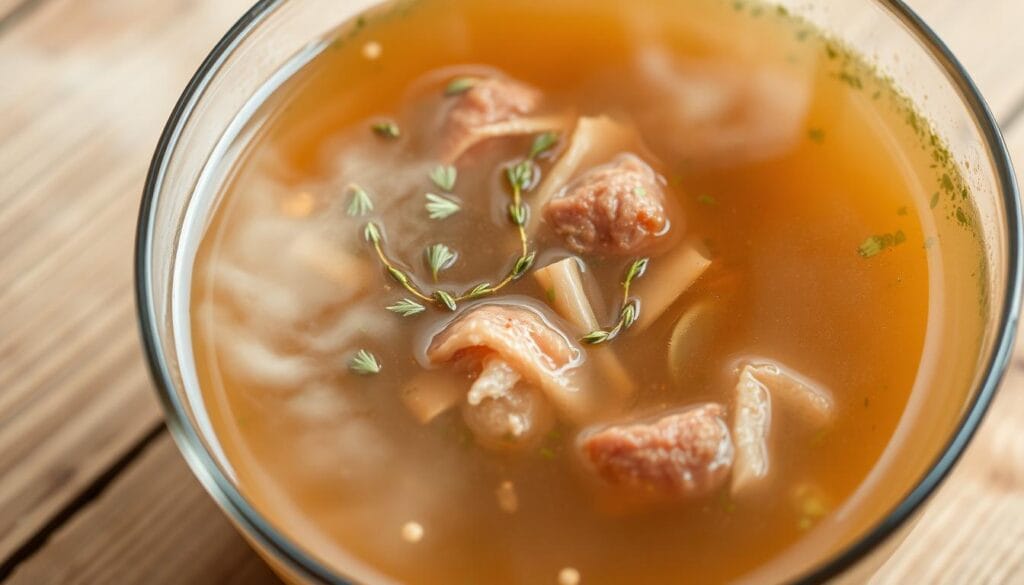
With this perfect beef broth, you’re ready to make an authentic and delicious pares dish. The key is to simmer low and slow to extract all the flavors. Mastering this broth will elevate your pares to new heights.
Step-by-Step Guide to Cooking Tender Braised Beef
Learning to cook tender braised beef is key to making great beef pares. Begin by blanching the meat. Blanching removes impurities and excess fat, making the broth clean and flavorful. Then, simmer the beef with aromatic ingredients until it’s incredibly tender.
Meat Preparation Techniques
- Blanch the beef: Bring a large pot of water to a boil. Add the beef cubes and let them blanch for 2-3 minutes. This will help remove any impurities or excess fat from the meat.
- Rinse and pat dry: Drain the beef and rinse it under cold water. Pat the meat dry with paper towels to remove any excess moisture.
Braising and Tenderizing Methods
The secret to tender braised beef is patience and gentle cooking. Simmering the meat with vegetables and spices breaks down connective tissues. This makes the meat melt-in-your-mouth tender.
- Add the beef to a large pot or Dutch oven and cover with beef broth or water.
- Toss in sliced onions, garlic cloves, whole black peppercorns, and bay leaves. Bring the liquid to a gentle simmer.
- Cover the pot and let the beef braise for 2-3 hours, or until the meat is fork-tender. Adjust the heat as needed to maintain a gentle simmer throughout the cooking process.
- For the asado-style braised beef, sauté aromatic ingredients like onions and garlic in a pan. Add the tender beef, then pour in a mixture of soy sauce, brown sugar, and star anise. Braise the beef until the sauce is reduced and the meat is fork-tender, about 30-45 minutes.
By following these steps, you’ll get tender, flavorful beef. This is the heart of a great beef pares dish.
Mastering the Garlic Fried Rice Component
Take your pares to the next level by mastering the garlic fried rice, or sinangag. This side dish perfectly complements the tender beef. It brings a balance of textures and tastes to your meal.
To make top-notch sinangag, use cold, day-old rice. This keeps each grain separate, avoiding clumps. Fry minced fried garlic in oil until it’s golden and crispy. Then, set it aside.
In the same pan, stir-fry the rice. Spread it out and toss it to heat evenly.
- Season the rice with a sprinkle of salt and white pepper, to taste.
- Toss the crunchy fried garlic back into the pan, thoroughly incorporating it throughout the rice.
This method ensures each rice grain is filled with fried garlic flavor. Your dish will look great and taste amazing.
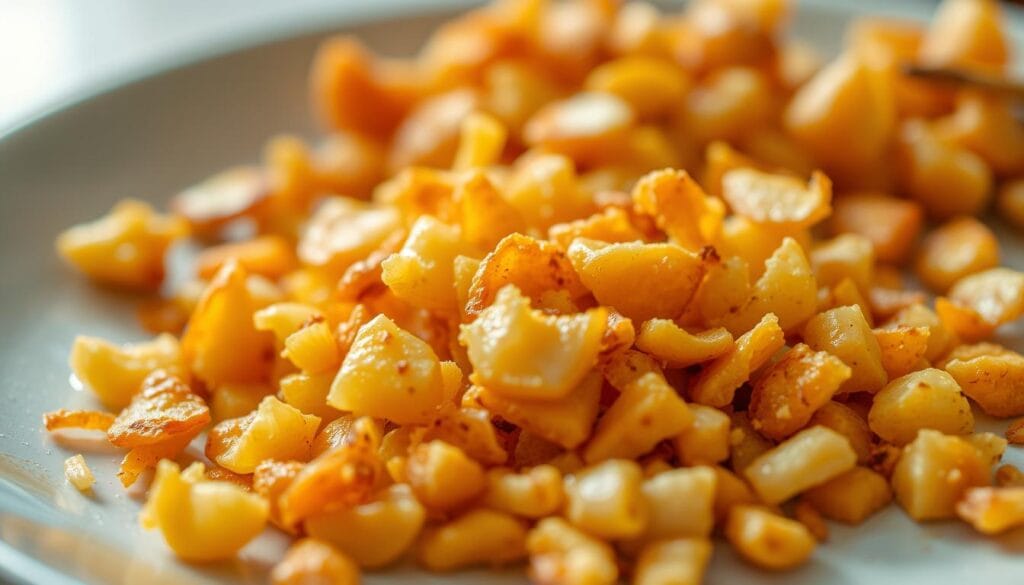
The secret to perfect sinangag is in the ingredients and cooking details. Use pruning techniques for the best texture and flavor. Your pares meal will be unforgettable.
Popular Regional Variations of Pares
The beloved Filipino dish pares has evolved over time. It now has several regional variations that cater to diverse taste preferences. Let’s explore two of the most popular pares styles that have gained widespread recognition.
Pares Kanto Style
Pares kanto, or street-style pares, combines beef and broth. It often has a thicker consistency thanks to cornstarch. This version is less sweet than traditional pares and uses beef tendons and fatty cuts. It adds a unique texture and flavor.
Pares Mami Variation
The pares mami variation blends pares with the classic Filipino egg noodle soup, mami. It creates a fusion dish that resembles the Vietnamese pho. This innovative combination has gained significant popularity, appealing to those seeking a heartier and more substantial pares experience.
Beyond these two regional interpretations, the world of pares has witnessed the emergence of creative culinary adaptations. The “pares overload” trend takes the pares kanto concept to new heights. It adds fried pork lechon and chicharong bulaklak, sometimes even incorporating whole stewed bone marrow. This creates an indulgent and visually striking presentation.
Whether you prefer the traditional pares, the street-style pares kanto, or the noodle-infused pares mami, the regional variations of this iconic Filipino dish offer a diverse range of flavors and textures. The evolution of pares continues to showcase the ingenuity and adaptability of Filipino cuisine. It delights both local and international food enthusiasts.
Tips for Achieving Restaurant-Quality Pares at Home
Getting your homemade beef pares to taste like a restaurant’s is easier than you think. Just a few simple steps can make your dish rich and flavorful, just like the ones you love. You can make this beloved Filipino dish in your own kitchen.
- Make the Broth from Scratch: Spend time making the beef broth ahead of time. It’s better to simmer bones, aromatics, and spices yourself. This way, you get a flavor that store-bought broths can’t match.
- Tenderize the Beef Quickly: Use a pressure cooker to tenderize the beef fast. This shortens the braising time, keeping the meat tender and juicy.
- Don’t Skimp on the Star Anise: Star anise is key for authentic pares. It adds a warm, slightly licorice-like flavor that’s essential.
- Enrich the Soup with Sauce: Add some of the reduced beef sauce to the soup before serving. It boosts the taste and texture.
- Use Cold, Leftover Rice for Sinangag: For the best garlic fried rice, use cold, cooked rice. It gives the right texture and prevents grains from sticking.
Mastering these techniques lets you make your favorite pares at home. You’ll impress your family and friends with your homemade pares recipe skills!
| Cooking Technique | Benefits |
|---|---|
| Make Broth from Scratch | Deeper, richer flavor |
| Use Pressure Cooker | Quickly tenderizes beef |
| Include Star Anise | Authentic pares flavor |
| Add Sauce to Soup | Enhances overall taste |
| Use Cold, Leftover Rice | Perfect sinangag texture |
“By mastering these simple techniques, you can bring the flavors of your favorite pares joints right to your own kitchen.”
The secret to great pares at home is in the details. With practice and these tips, you’ll make pares that everyone will want more of.
Serving Suggestions and Traditional Accompaniments
When serving pares, tradition is key. It’s usually served with braised beef and garlic fried rice on one plate. A steaming bowl of rich, aromatic broth is on the side. Fresh green onions on top add color and flavor.
There are many ways to enjoy pares. Some like it with steamed rice for a lighter option. Others prefer noodles, like mami, for a heartier meal.
Pares can be a standalone dish or paired with other Filipino favorites. Adobo, lumpia, or ensaladang talong (eggplant salad) are great choices. They enhance the savory flavors of pares, making the meal complete.
For a healthier twist, try pares with a kamote (sweet potato) salad or a fruit salad. Mangoes, papayas, and pineapples add tropical flavors. These side dishes balance the richness of pares.
The secret to loving pares is enjoying its mix of tender beef, aromatic broth, and rice or noodles. Exploring different serving styles and sides can make pares even more special.
Health and Nutritional Aspects of Beef Pares
Beef pares is a favorite Filipino dish that’s not just tasty but also good for you. The beef is packed with protein, which is key for building muscles and keeping your body running smoothly.
The broth in pares is more than just tasty. It helps keep you hydrated and might even have good stuff from the bones. But, it’s worth noting that pares can have a lot of sodium and fat, especially in restaurants.
Garlic-fried rice, or sinangag, is a big part of pares. Garlic is full of health-promoting properties. It has antioxidants and anti-inflammatory effects that can boost the dish’s nutritional value.
Traditional pares is a balanced meal. But, some versions, like “pares overload” with extra pork, can be very high in fat and cholesterol. It’s important to watch your portions and what you add to enjoy these richer versions.
“Beef pares is a protein-rich dish that can be part of a balanced diet, but portions and ingredients should be considered for optimal health benefits.”
Beef pares can be a healthy choice if you eat it in moderation and as part of a balanced diet. Knowing the nutritional value, protein content, and different versions helps you make smart choices. This way, you can enjoy this beloved Filipino dish while keeping your health in mind.
Conclusion
The story of beef pares is truly inspiring. It started as a simple street food and grew into a favorite in Filipino cuisine. This dish has won the hearts of many, becoming a go-to comfort food for all times.
The mix of tender beef, rich broth, and garlic fried rice is unmatched. It’s enjoyed in both traditional spots and fancy restaurants. Pares shows the beauty of Filipino food culture, celebrating the country’s heritage and love for comfort.
Exploring Filipino cuisine means trying pares recipe. It’s more than just food; it’s a warm hug for your soul. Let pares remind you of the richness and variety of Filipino cuisine. It’s a world of comfort food that keeps on enchanting us.

